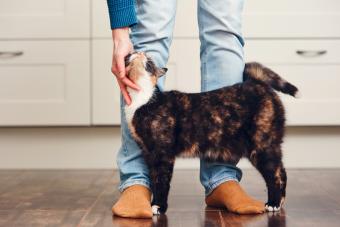
Cat breeding can be a rewarding experience, but it's not an operation to be taken lightly. In order to decide whether you want to breed your cat, it's important to understand the entire process. This ranges from cats mating to the birth of the kittens. And onto finding the best home. You must be prepared for the entire process.
Understanding Cats Mating and Breeding
Cat breeding seems to be slightly less complicated than dog breeding, since you don't need to be as precise about the timing, and felines seem to be far more self-sufficient at handling the mating themselves. But it's more of a process than it appears to be.
Female Heat Cycle
The female cat's heat cycle is the first step in the breeding process. This is the time when she is most fertile and receptive to a male cat's advances. Cycles usually begin when a female reaches 6 months old, and only last two days on average, but are repeated approximately every two weeks thereafter unless mating takes place. Once a cat has mated and becomes pregnant, her heat cycles will end.

It's not always easy to detect when the heat cycle begins, since the female's vulva is obscured by fur, and there isn't normally a great deal of bloody discharge.
Signs Your Cat is Ready for Breeding
Since cats don't leave traces of blood behind during heat, many breeders rely on their female cat's behavior to let them know when she is coming into breeding condition. By observing your cat on a regular basis, you will be able to notice even subtle differences in her behavior. These differences include:

- Flirting: Females become more affectionate than normal. Some become affectionate to the point that it is overwhelming, whereas others will become just slightly more friendly.
- Rump raising: Females in heat will tend to raise their rumps when you stroke them along their backs.
- Tail flagging: Rump raising may be accompanied by a quick back and forth twitching of the tail. This is the way the female advertises her readiness.
- Calling: Females in heat can be extremely vocal, calling constantly in search of male partners. Any capable male within earshot will do their best to answer that call.
Female cats are ready to mate as early as four months old, but male cats may not be prepared until at least seven months.
Cat Mating Activity
When the male mounts the female, he will latch onto her with his claws and frequently hold the scruff of her neck with his teeth. The barbs on his penis act as a stimulus to encourage the female's immediate ovulation, thus ensuring the success of most matings.
Mating can appear to be overly rough. Don't be alarmed; this is normal during the cat mating process.
Your Cat's Pregnancy
Once you confirm your cat is pregnant, you can stop worrying about breeding and move on to how to care for her. You will notice differences in your female cat as the pregnancy progresses. She will have different needs during each stage.

The success of the mating can be confirmed within three to four weeks after mating.
Gestation Period and Nutrition
The gestation period, or length of a cat pregnancy, is approximately 65 days. However, large litters may arrive a day or two sooner, and small litters may be a day or so late.
During the gestation period, the pregnant female, or queen, as she is now referred to, needs increased nutrition to help her provide everything her growing fetuses need without depleting her own resources. Kitten food makes an excellent diet for her since it is higher in protein, minerals, and vitamins than adult cat food mixes.
It's also a good idea to begin offering multiple meals throughout the day from about the fifth week of the pregnancy. This will ensure that your cat is able to consume enough food without overloading her stomach, since internal space is at a premium with each advancing week. Be sure to keep her water dish filled and refresh it several times each day.
Mother's Behavior During Pregnancy
As your cat's pregnancy progresses, she may start eating more than she normally does, not only nourishing herself, but also her kittens. She may also start looking for safe, quiet places around your home.
This is known as "nesting" and it's a process involving her searching for where she plans to give birth. Towards the end of her pregnancy, she may show signs of restlessness and discomfort due to the physical burden of carrying kittens.
Preparing for Birth of Kittens
Toward the end of the pregnancy, a queen will begin looking for a private, warm area to deliver her babies. If you don't provide one, the spot may just wind up being your bed. Or under your bed. Although you can't force her to give birth where you choose, you can create one and hope she uses it.

A sufficiently roomy box lined with newspapers and a soft blanket makes a good spot for the delivery, or queening as it's properly called. Place the box in a quiet place away from traffic a few weeks before the expected birth, so the mom-to-be will have time to discover and get used to it.
Put an additional litter box in the area at this time, so mom will be comfortable using it when she feels reluctant to leave her new babies.
Your Cat in Labor
As labor approaches, your cat might lose her appetite, and there could be some discharge from her vagina. Most notably, as labor approaches, your cat might start grooming excessively, particularly around her abdomen and genital area. It's crucial to be observant of these signs and to ensure your cat has a safe and comfortable space where she can give birth.
Kitten Delivery
Most queens take care of the delivery quite well on their own, and you may not even realize the event has taken place until you discover mom and kittens cuddled up together. If you do arrive during delivery and all is going well, it's best not to intervene.
Just be on hand in case you need to assist with removing a sack from one of the kittens, or tie off an umbilical cord with a bit of string if it continues to bleed after severing from the placenta. Move mom's food dishes just outside of the box so she won't have to travel far from her babies to get sustenance.
Before delivery approaches, jot down the phone number of an on-call veterinarian in case of emergency.
How Long is a Normal Delivery?
The duration of cat delivery, also known as parturition, can vary widely depending on the individual cat and the size of the litter. In general, once a cat begins active labor, the delivery of the kittens typically begins within a few hours.
Each kitten is usually born about 15 to 30 minutes apart. If there are multiple kittens, the entire process can last up to six or seven hours. However, in some cases, it can take up to 24 hours with resting phases in between the birth of each kitten.
Put Your Cat's Health First
Some female cats aren't healthy enough to breed. Check with your vet to confirm your cat is healthy enough for breeding and proceed responsibly from that point forward. If you change your mind at any point before breeding, follow all the proper steps to stop your cats from mating. If your cat is bred, ensure you are prepared to care for the mother and kittens while they await their forever homes.







